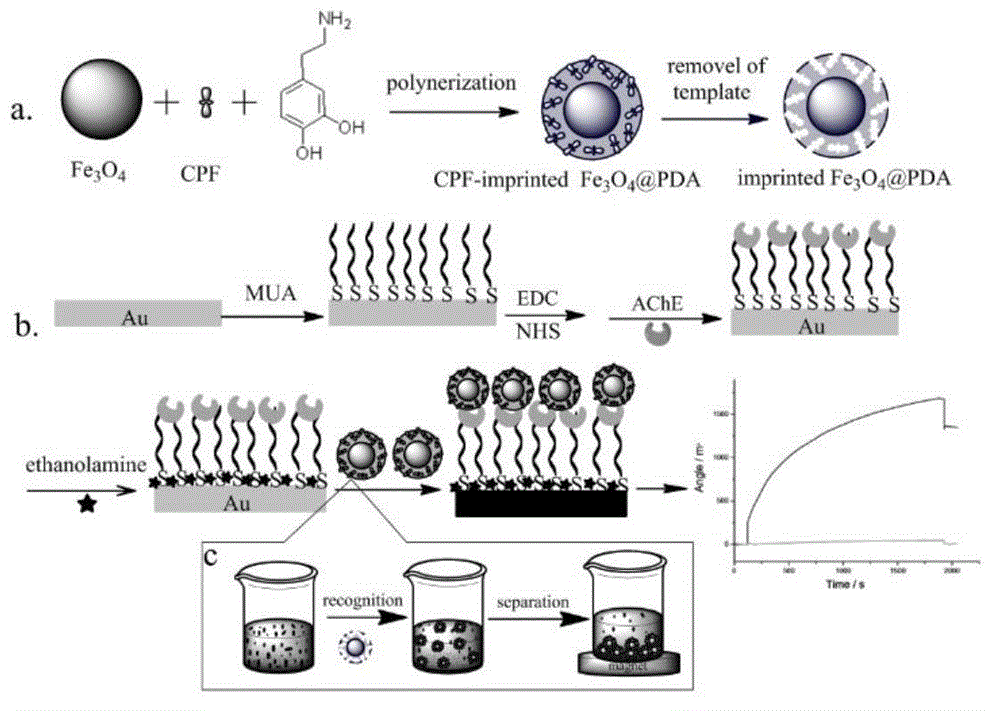Application of spr sensor based on the amplification effect of magnetic molecularly imprinted polymers in the detection of pesticides
A magnetic molecular imprinting and polymer technology, applied in instruments, measuring devices, scientific instruments, etc., can solve the problems of high particle diffusion resistance, difficult elution of template imprinted molecules, and reduce the utilization rate of imprinted sites, so as to improve the binding capacity , good application prospects, fast association/dissociation rate effect
- Summary
- Abstract
- Description
- Claims
- Application Information
AI Technical Summary
Problems solved by technology
Method used
Image
Examples
Embodiment 1
[0026] (1) Fe 3 o 4 Preparation of NPs: 2.35g FeSO 4 ·7H 2 O and 4.1 g FeCl 3 ·6H 2 O was dissolved in 90mL of water, and 25mL of ammonia water with a mass percentage concentration of 25% was quickly added at room temperature. 7nm Fe 3 o 4 NPs. The above experimental process needs to be carried out under the protection of nitrogen. Finally, the Fe in the solution is 3 o 4 NPs were isolated and stored at 4°C for future use;
[0027] (2) Preparation of magnetic molecularly imprinted polymer: 50mg Fe 3 o 4 NPs were dissolved in 20 mL, 10 mM, pH 8.0 Tris buffer solution, 5 mL of acetonitrile solution containing 1 mg / mL CPF was added, mechanically stirred for 2 h at room temperature, then 25 mg DA was added, and stirring was continued for 4 h at room temperature; the reaction product was separated with a magnet, and The mixed solution of 3% acetic acid by volume and 20% acetonitrile by volume eluted the imprinted CPF molecules and unpolymerized DA until the ultraviolet...
Embodiment 2
[0032] Construction of SPR sensing interface
[0033] (1) The construction process of the SPR sensing interface is as follows: figure 1 shown. First place the gold flakes in H with a volume ratio of 7:3 2 SO 4 :H 2 o 2 Soak in the mixed solution for 2 minutes, rinse with secondary water and blow dry with nitrogen, and install it into the SPR detection cell. Inject 50 μL of 1 mM 11-mercaptoundecanoic acid solution into the detection cell to react for 2 hours, rinse with secondary water, inject 50 μL of 0.2M 1-ethyl-3-(3-dimethylaminocarbodiimide) hydrochloride and 0.05MN -Hydroxysuccinimide mixed solution was reacted for 10 min, and then injected with 50 μL 2U / mLAChE solution for 30 min; finally, 50 μL of 1.0M ethanolamine solution was injected for 10 min, and after washing with 10 mM Tris buffer solution of pH 8.5, the AChE functionalized SPR was obtained. sensor interface;
[0034] (2) Combining CPF with MIP-Fe 3 o 4 PDANPs were mixed at room temperature and incubate...
Embodiment 3
[0037] (1) Influence of polymerization time, pH of polymerization solution, and pH of recombination medium solution on sensor performance
[0038] Figure 6 A is the effect of DA aggregation time on sensor performance. It can be seen from the figure that as the polymerization time prolongs, the SPR angle change (ΔAngle) gradually increases. When the polymerization time is 4h, ΔAngle reaches the maximum, and after more than 4h, ΔAngle decreases. If the polymerization time is too short, the number of imprinted sites is small, resulting in weak adsorption capacity for CPF; if the polymerization time is too long, the thickness of the PDA film will be large, and the elution efficiency of CPF will be low, which will lead to a decrease in the adsorption capacity of molecular imprinting. Therefore, the best polymerization time for choosing DA is 4h. Figure 6 B is the effect of the pH of the polymerization solution on the performance of the sensor. Lower pH will inhibit the self-po...
PUM
| Property | Measurement | Unit |
|---|---|---|
| particle size | aaaaa | aaaaa |
Abstract
Description
Claims
Application Information
 Login to View More
Login to View More - R&D
- Intellectual Property
- Life Sciences
- Materials
- Tech Scout
- Unparalleled Data Quality
- Higher Quality Content
- 60% Fewer Hallucinations
Browse by: Latest US Patents, China's latest patents, Technical Efficacy Thesaurus, Application Domain, Technology Topic, Popular Technical Reports.
© 2025 PatSnap. All rights reserved.Legal|Privacy policy|Modern Slavery Act Transparency Statement|Sitemap|About US| Contact US: help@patsnap.com



